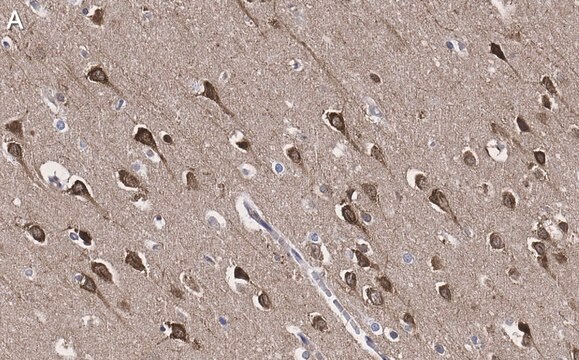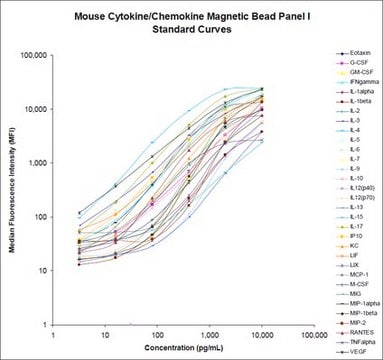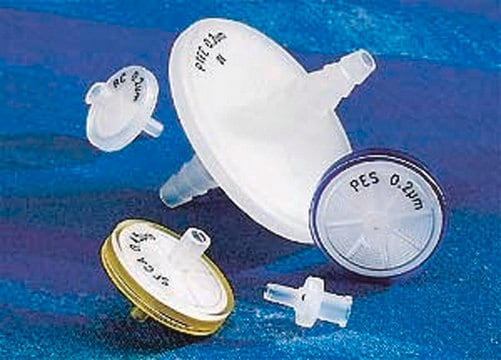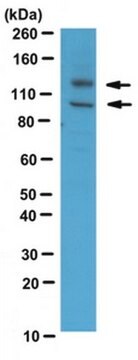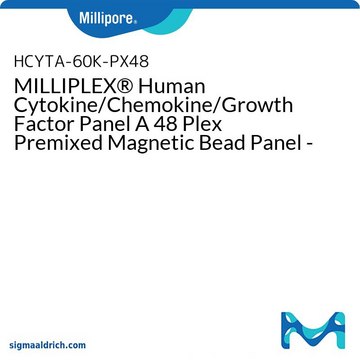AB19026
Anti-ADAM 10 Antibody, CT
Chemicon®, from rabbit
Sinonimo/i:
A disintegrin and metalloproteinase domain 10, ADAM metallopeptidase domain 10, CD156c antigen, Kuzbanian protein homolog, Mammalian disintegrin-metalloprotease, a disintegrin and metalloprotease domain 10
About This Item
Prodotti consigliati
Origine biologica
rabbit
Livello qualitativo
Forma dell’anticorpo
purified antibody
Tipo di anticorpo
primary antibodies
Clone
polyclonal
Reattività contro le specie
bovine, mouse, human
Reattività contro le specie (prevista in base all’omologia)
rat
Produttore/marchio commerciale
Chemicon®
tecniche
immunofluorescence: suitable
immunohistochemistry: suitable (paraffin)
western blot: suitable
N° accesso NCBI
N° accesso UniProt
Condizioni di spedizione
wet ice
modifica post-traduzionali bersaglio
unmodified
Informazioni sul gene
rat ... Adam10(29650)
Descrizione generale
Tumor-necrosis factor alpha is a proinflammatory cytokine and contributes to a variety of inflammatory disease responses and programmed cell death. Notch receptor and its ligand participate in cell fate decisions during vertebrate development and are associated with several human disorders, including a T-cell lymphoma. TNA-alpha, notch and its ligand delta are all membrane-bond molecules, which are cleaved by proteases to release mature proteins or functional receptor. ADAM10-, a metalloprotease-disintegrin in the family of mammalian ADAM (for a disintegrin and metalloproteinase domain), was recently identified to cleave TNF-alpha, notch and its ligand delta (1-3). The genes encoding human, mouse, and bovine ADAM10 were recently cloned and designated ADAM10, kuzbanian (KUZ), and MADM, respectively, (1,2,4). ADAM10mRNA is expressed in a variety of human and bovine tissues.
Specificità
Immunogeno
Applicazioni
1:500 - 1:2,000 dilution. Jurkat whole cell lysate can be used as a positive control and an 85 kDa band can be detected which may represent precursor. A 60 kDa faint band was detected in some cell lines including Jurkat, which appears to be the processed mature protein. Overloading of the primary antibody can lead to multiple bands appearing in some preparations. The presence of glycosylated forms and breakdown products can lead to other bands. A prominent proform at near 80-85 is usually seen, with bands at 60, and below 50 kDa in most cases. The immunogen peptide is available (Cat. No. AG533) for performing antibody blocking studies.
Optimal working dilutions must be determined by end user.
Immunohistochemistry:
A previous lot of this antibody was used to detect ADAM10 in formalin-fixed, paraffin-embedded renal tissue and renal cell carcinoma tissue (Gutwein, P., et al. EUROPEAN JOURNAL OF CANCER. 45(2009):478–489).
Immunofluorescence:
A previous lot of this antibody was used to detect ADAM10 in RCC4 (renal cell carcinoma) and A498 cells (Gutwein, P., et al. EUROPEAN JOURNAL OF CANCER. 45(2009):478–489).
Qualità
Western Blot: 1:500 dilution of this lot detected ADAM 10 on 10 μg of RAW264.7 lysates
Descrizione del bersaglio
Linkage
Stato fisico
Stoccaggio e stabilità
Handling Recommendations:
Upon receipt, and prior to removing the cap, centrifuge the vial and gently mix the solution. Aliquot into microcentrifuge tubes and store at -20°C. Avoid repeated freeze/thaw cycles, which may damage IgG and affect product performance.
Risultati analitici
ADAM 10 is ubiquitously expressed. MDA-MB231 (Human breast cancer cell line known to express high levels of ADAM 10).
Altre note
Note legali
Non trovi il prodotto giusto?
Prova il nostro Motore di ricerca dei prodotti.
Raccomandato
Codice della classe di stoccaggio
12 - Non Combustible Liquids
Classe di pericolosità dell'acqua (WGK)
WGK 2
Punto d’infiammabilità (°F)
Not applicable
Punto d’infiammabilità (°C)
Not applicable
Certificati d'analisi (COA)
Cerca il Certificati d'analisi (COA) digitando il numero di lotto/batch corrispondente. I numeri di lotto o di batch sono stampati sull'etichetta dei prodotti dopo la parola ‘Lotto’ o ‘Batch’.
Possiedi già questo prodotto?
I documenti relativi ai prodotti acquistati recentemente sono disponibili nell’Archivio dei documenti.
Il team dei nostri ricercatori vanta grande esperienza in tutte le aree della ricerca quali Life Science, scienza dei materiali, sintesi chimica, cromatografia, discipline analitiche, ecc..
Contatta l'Assistenza Tecnica.